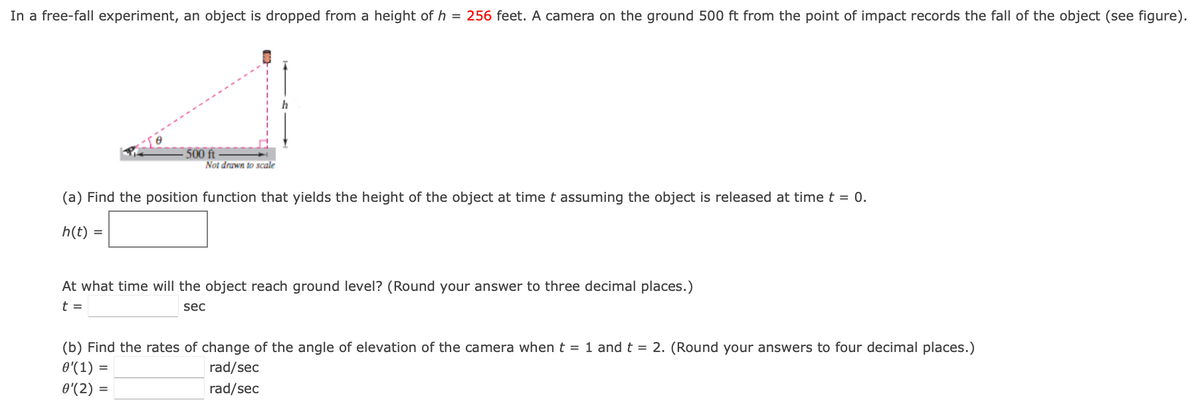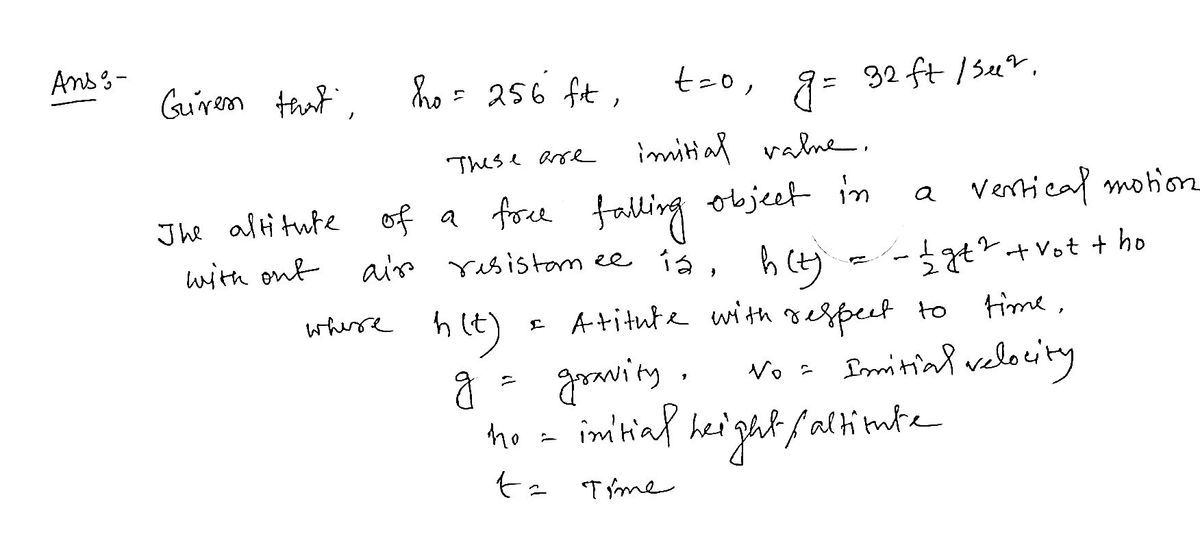In a free-fall experiment, an object is dropped from a height of h = 256 feet. A camera on the ground 500 ft from the point of impact records the fall of the object (see figure). 500 ft Not dewn to scale (a) Find the position function that yields the height of the object at time t assuming the object is released at time t = 0. h(t) = At what time will the object reach ground level? (Round your answer to three decimal places.) t = sec (b) Find the rates of change of the angle of elevation of the camera when t = 1 and t = 2. (Round your answers to four decimal places.) O"(1) = rad/sec O"(2) = rad/sec
In a free-fall experiment, an object is dropped from a height of h = 256 feet. A camera on the ground 500 ft from the point of impact records the fall of the object (see figure). 500 ft Not dewn to scale (a) Find the position function that yields the height of the object at time t assuming the object is released at time t = 0. h(t) = At what time will the object reach ground level? (Round your answer to three decimal places.) t = sec (b) Find the rates of change of the angle of elevation of the camera when t = 1 and t = 2. (Round your answers to four decimal places.) O"(1) = rad/sec O"(2) = rad/sec
College Algebra
7th Edition
ISBN:9781305115545
Author:James Stewart, Lothar Redlin, Saleem Watson
Publisher:James Stewart, Lothar Redlin, Saleem Watson
Chapter4: Exponential And Logarithmic Functions
Section4.6: Modeling With Exponential Functions
Problem 17E: radioactive Decay These exercises use the population radioactive Decay. Radioactive Radium The half...
Related questions
Question

Transcribed Image Text:In a free-fall experiment, an object is dropped from a height of h = 256 feet. A camera on the ground 500 ft from the point of impact records the fall of the object (see figure).
h
500 ft
Not drawn to scale
(a) Find the position function that yields the height of the object at time t assuming the object is released at time t = 0.
h(t) =
At what time will the object reach ground level? (Round your answer to three decimal places.)
t =
sec
(b) Find the rates of change of the angle of elevation of the camera when t = 1 and t = 2. (Round your answers to four decimal places.)
O'(1)
rad/sec
%D
O'(2)
rad/sec
Expert Solution
Step 1

Trending now
This is a popular solution!
Step by step
Solved in 2 steps with 2 images

Recommended textbooks for you

College Algebra
Algebra
ISBN:
9781305115545
Author:
James Stewart, Lothar Redlin, Saleem Watson
Publisher:
Cengage Learning


Algebra and Trigonometry (MindTap Course List)
Algebra
ISBN:
9781305071742
Author:
James Stewart, Lothar Redlin, Saleem Watson
Publisher:
Cengage Learning

College Algebra
Algebra
ISBN:
9781305115545
Author:
James Stewart, Lothar Redlin, Saleem Watson
Publisher:
Cengage Learning


Algebra and Trigonometry (MindTap Course List)
Algebra
ISBN:
9781305071742
Author:
James Stewart, Lothar Redlin, Saleem Watson
Publisher:
Cengage Learning

Functions and Change: A Modeling Approach to Coll…
Algebra
ISBN:
9781337111348
Author:
Bruce Crauder, Benny Evans, Alan Noell
Publisher:
Cengage Learning

Algebra & Trigonometry with Analytic Geometry
Algebra
ISBN:
9781133382119
Author:
Swokowski
Publisher:
Cengage

Glencoe Algebra 1, Student Edition, 9780079039897…
Algebra
ISBN:
9780079039897
Author:
Carter
Publisher:
McGraw Hill